Arepas are a delicious, warm Colombian dish that are easy to grab and go and can be customized to your liking. These toasty little pockets of dough make an excellent breakfast, snack, or can be stuffed with cheese and meat for a quick lunch.
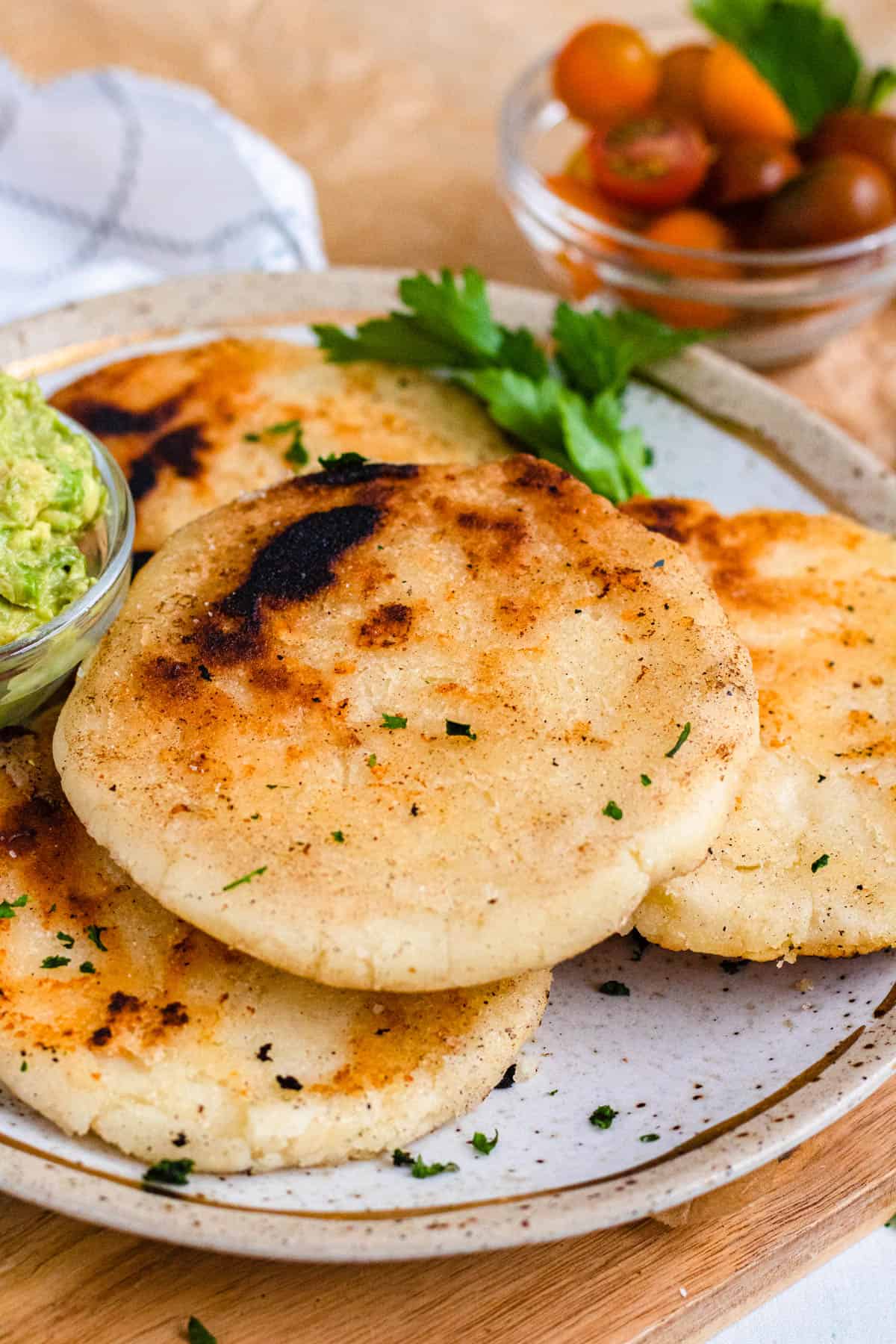
Hello Reader! I try my hardest to research recipes as best as I can before posting to ensure I am representing each culture correctly. If this recipe is from your country and I have made a mistake or you have suggestions for how to make it more authentic, I would love to hear! Please leave a comment below letting me know what should be different, and I will rework the recipe. It is always my intention to pay homage and respect to each cultural dish that I cook. Thanks for reading!
Spend any time in Colombia and you are sure to stumble across arepas. These warm corn cakes are eaten for breakfast, lunch, or even as a snack or a side with dinner.
Like most dishes that have been around for a long time, there is a lot of discussion about the proper way to make Colombian arepas. Some are made thick and stuffed, some are thin and topped, some are sliced, and still, others are simply eaten plain.
They may be grilled over coals, cooked up on a griddle, or even deep fried, and each new cooking method adds a different flavor to the cornmeal cake.
The great news about arepas is any way you try them, they are undeniably delicious.
Arepas are a little bit like a thick tortilla but with cheese mixed right into the dough. They are chewy and honestly just melt in your mouth.
The arepa itself has a mild flavor, which makes it perfect to pair with cheese, meat, beans, eggs, and any variety of sweet or spicy sauces. These toppings may be added to the top of an arepa or stuffed inside (though this is more popular in Venezuela). Many Colombians enjoy them plain with a little bit of butter and salt.
Arepas are a popular dish in part because of how easily they can be made and shared. They are often served as a quick breakfast, lunch or snack and are sold by street vendors in South America as a quick meal on the go.
Arepa Flour: Masarepa Vs. Masa Harina
The toughest part about making arepas is finding the right ingredients. These are simple ingredients, but they are also very important to get the right results. Those who make arepas consistently will tell you you must use masarepa.
Masarepa is a refined, pre-cooked cornmeal flour made from ground cornmeal, but it is not the same as regular cornmeal. It is soft and starchy and provides the perfect texture for arepas. It also has a very mild flavor.
Some of the most popular brands of masarepa are Harina P.A.N. and Goya. In areas with a large Latin American population, you may be able to find these brands at Walmart or Costco. Otherwise, you may be able to find it at a Latin American grocery store or order it online.
Masarepa differs from cornmeal because cornmeal is milled raw while masarepa is precooked. Foods Guy does a great job of explaining the difference if you are curious. In short, cornmeal does not absorb liquid the same way masarepa does, and your dough will not achieve the correct texture.
Recipe Origins
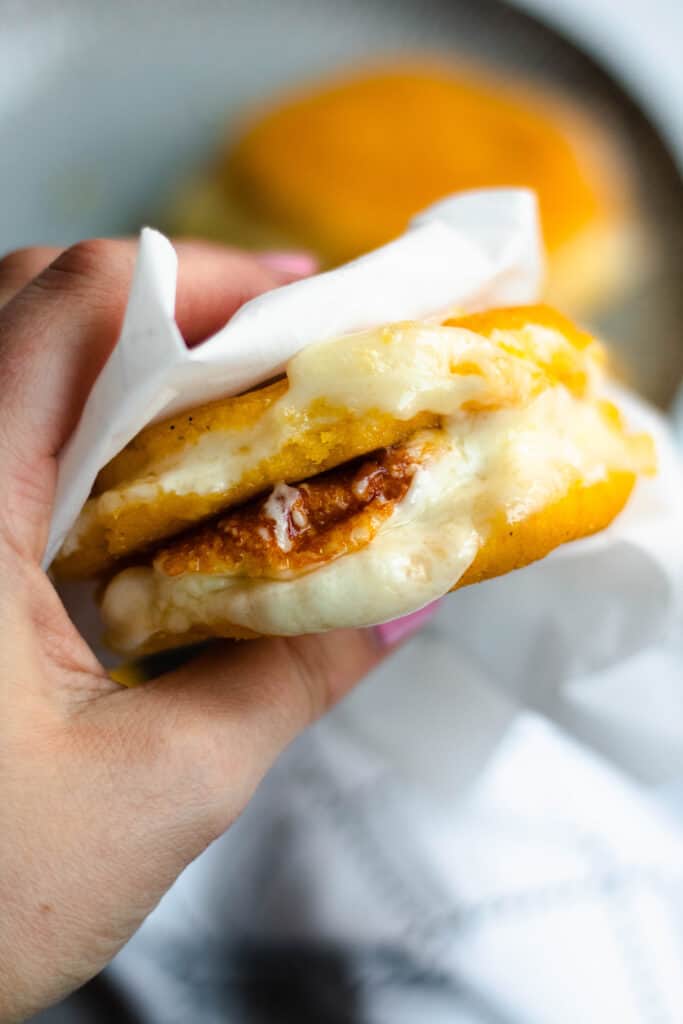
The history of arepas pre-dates the country of Colombia itself, to a time when Venezuela and Colombia were a part of the same country.
The indigenous people of what is now Venezuela, the Caribs and Cumanagoto tribes, are credited with making the first arepas. The word arepa may come from their word for maize, ‘erepa’ or it may come from the clay pan the dish was cooked on, called aripos.
Originally, the women from these indigenous tribes would chew the corn and then spit it out to form the dough. Thankfully, over time they learned how to grind the corn with stones. It’s a time-consuming process that made the dish a delicacy for many years, but some chefs still continue this process, swearing by the flavor the freshly ground corn adds.
In the 1950’s the process to create the special corn flour was industrialized, making the dish more accessible for all people.
Today it is enjoyed by people all over Colombia and Venezuela at all times of day as a meal, snack or side dish.
Why Make This Recipe
- Great On-The-Go Meal: Arepas are easy to make and take for a quick breakfast or lunch.
- Customize to Your Liking: Arepas are served with so many different toppings from simple queso to shredded beef, shrimp or eggs. Whatever you like, the mild flavor of the arepa will complement it perfectly.
- Taste of Colombia: If you’ve ever taken a trip to Colombia you know how often arepas are served. If you want to bring a little bit of colorful Colombia to your home, making your own arepas is the way to go!
What Do I Need to Make This Recipe?
Ingredients
Here is a visual overview of the ingredients in the recipe. Scroll down to the recipe at the bottom for quantities.
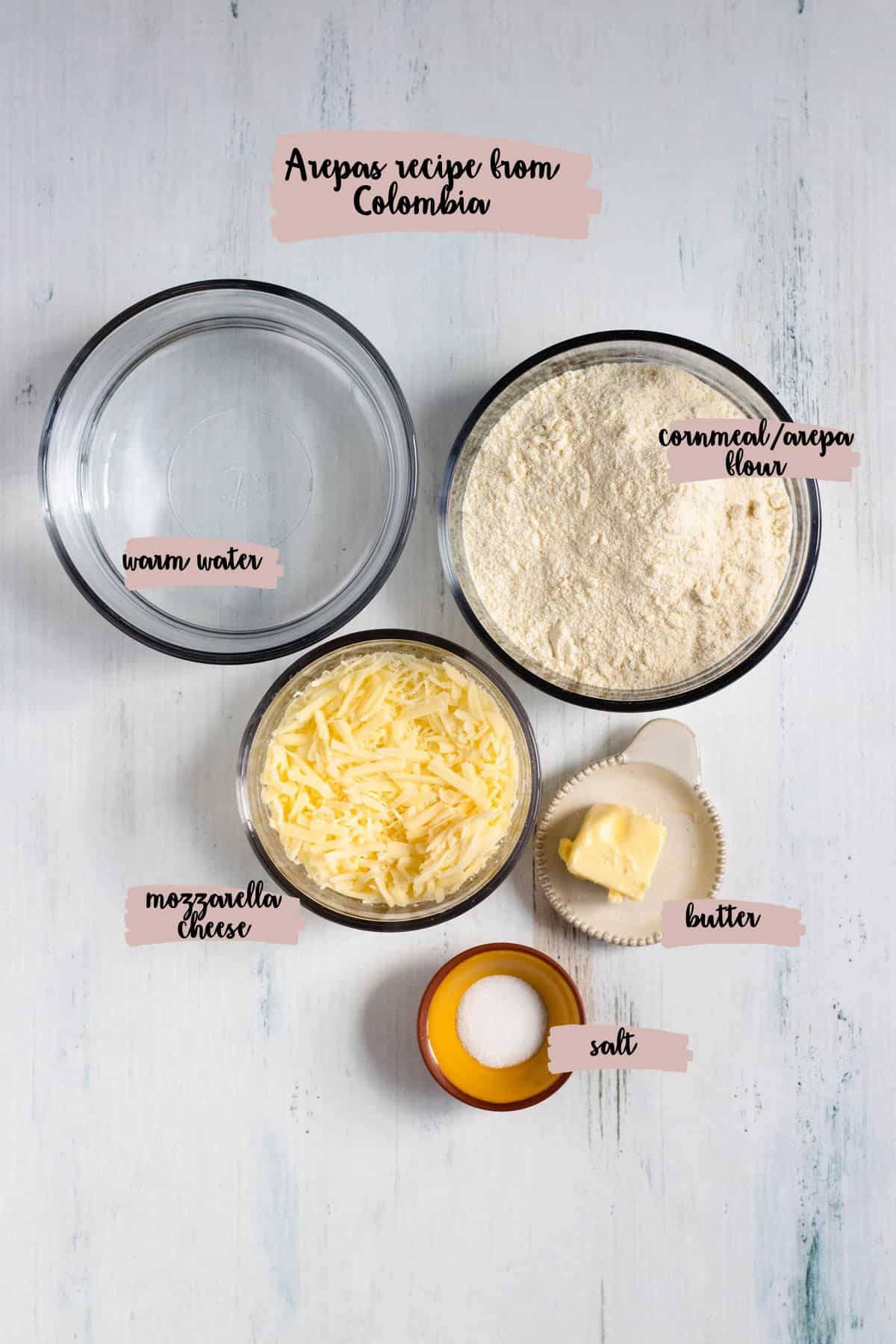
- Arepa Flour/Masarepa: Read the Arepa Flour section for more guidance on finding the right product.
- Water: Warm water will make the dough more pliable and less likely to crack
- Shredded Cheese: For an accessible option, you can use mozzarella cheese. Traditional choices are queso campesino or queso costeño.
- Butter: Softened. This is used in the dough as well as for cooking on the griddle.
Tools:
- Mixing Bowl
- Large Skillet or Griddle
How to Make This Recipe
Step One: Mix the Dough
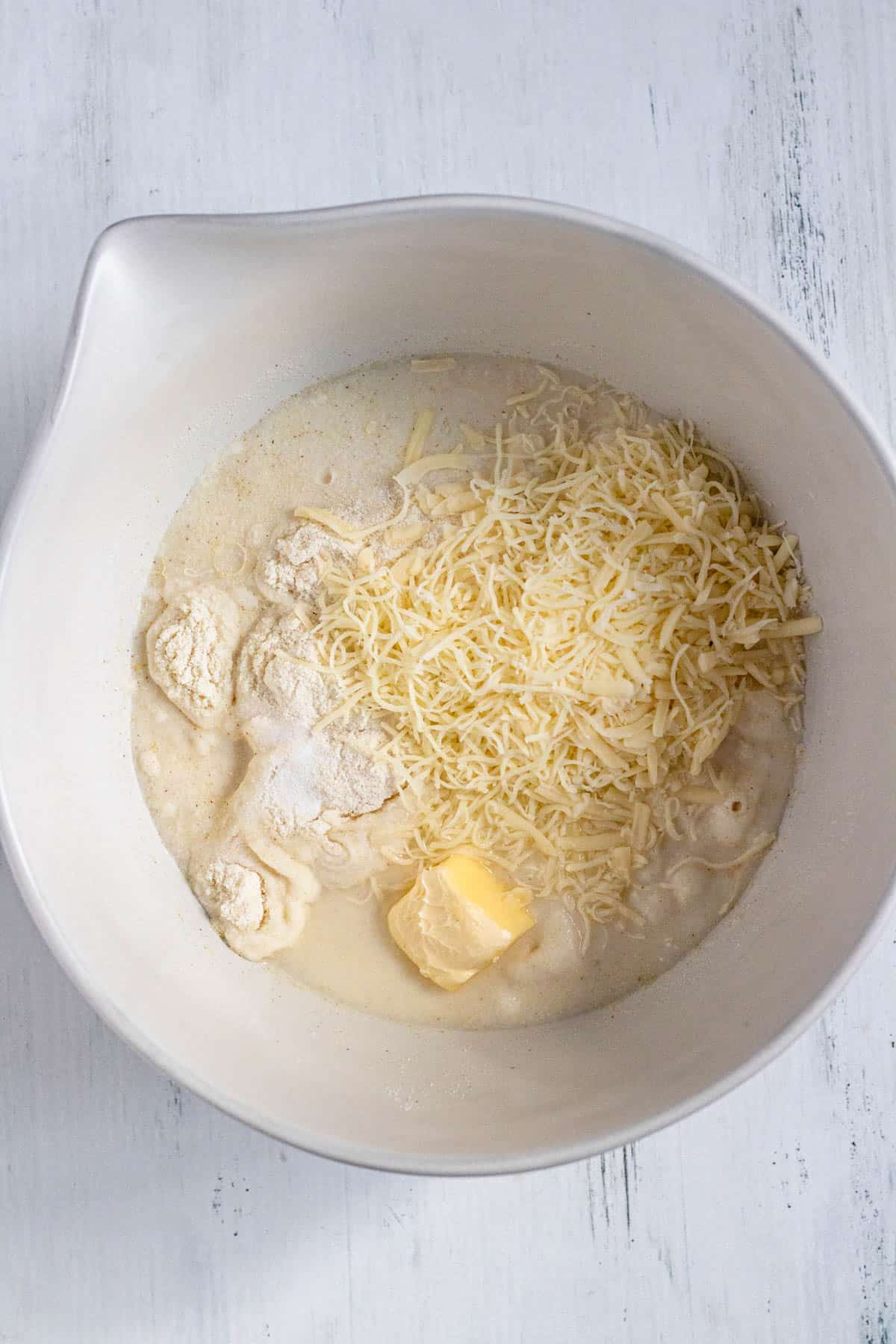
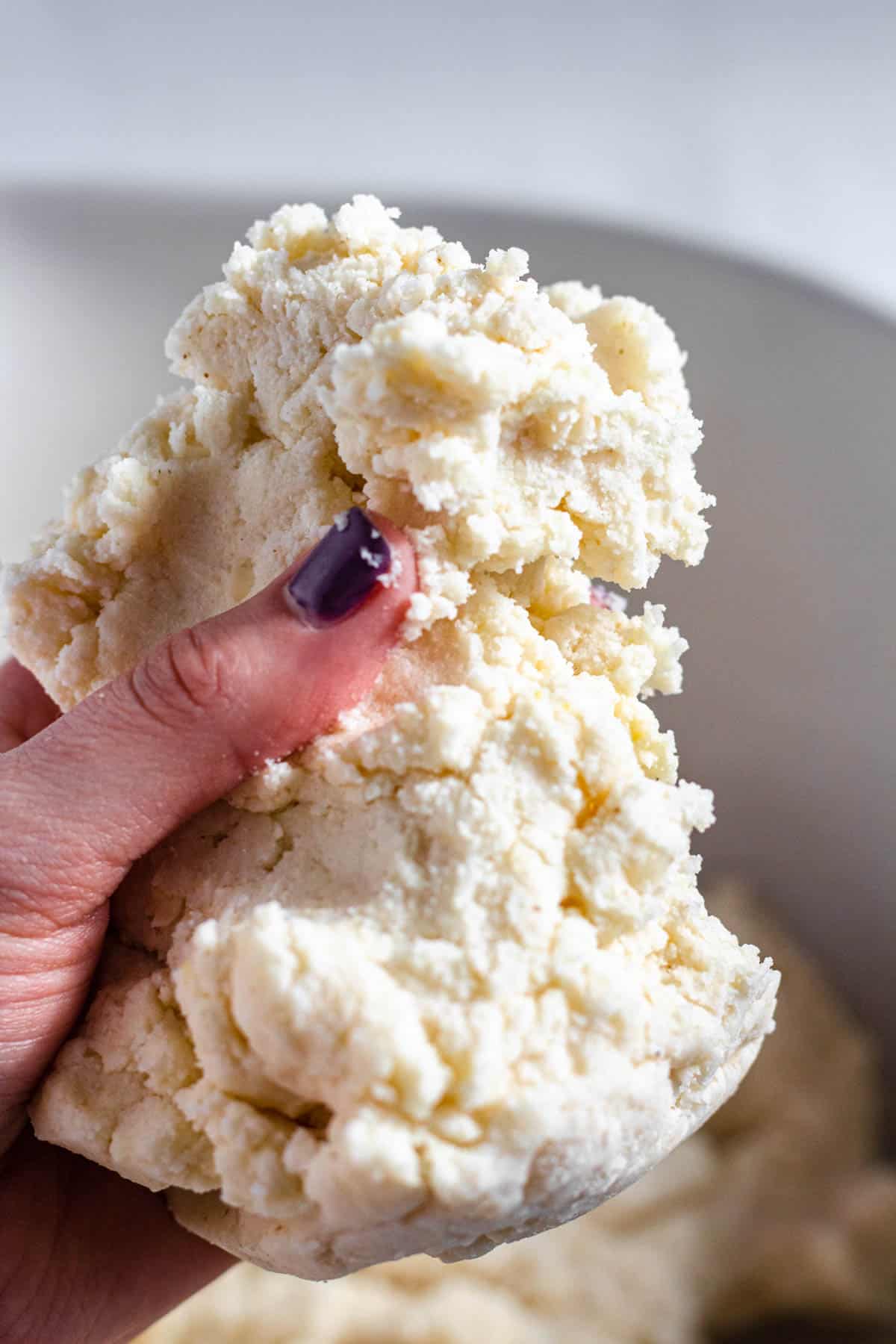
In a large or medium bowl, place the white cornmeal, salt, water, cheese, and 2 tbsp of butter. Use your hands to mix the dough thoroughly. Cover with a towel and let it rest at room temperature for 5 minutes.
Step Two: Form Your Arepas
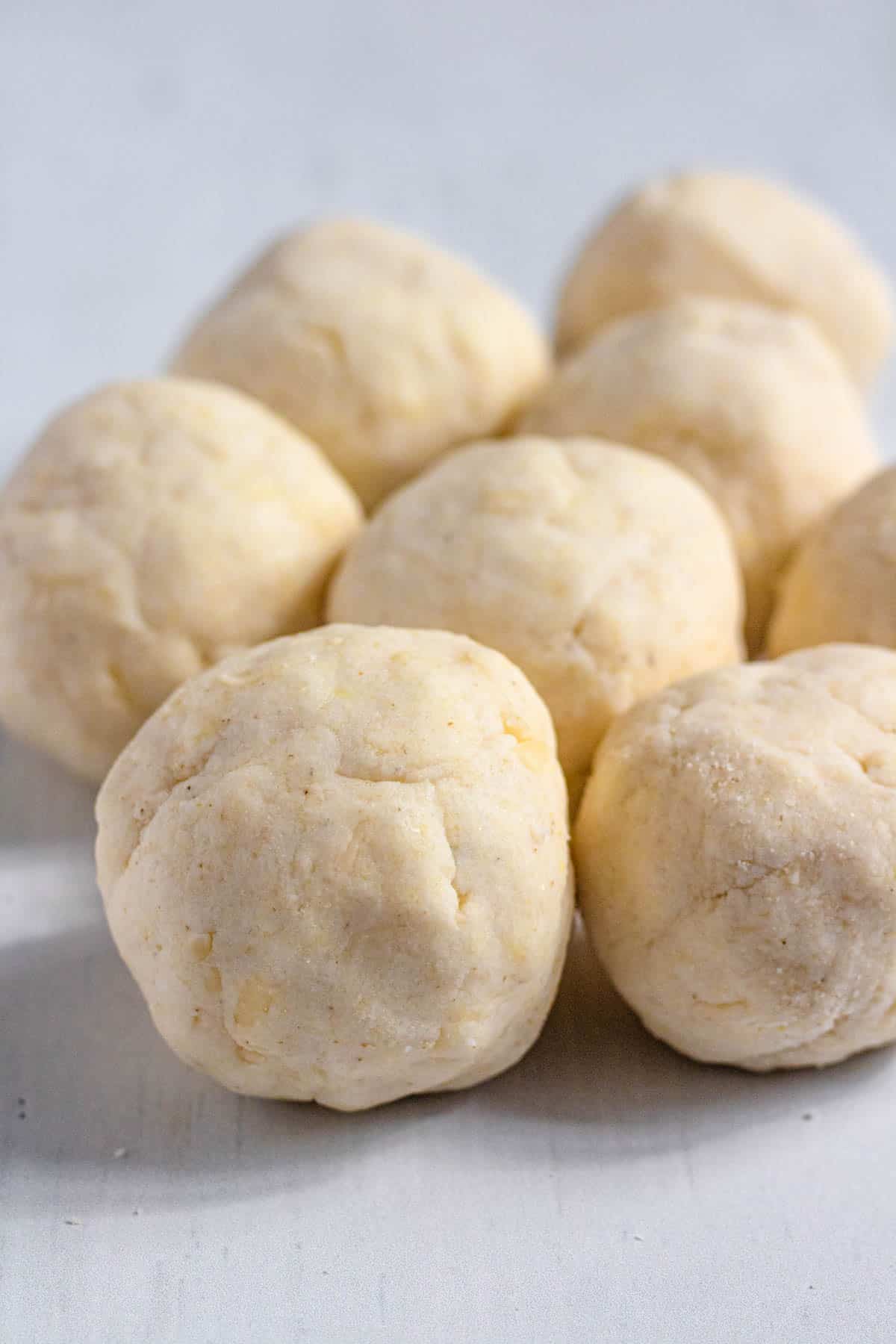
Separate the dough into 8 sections and roll each section into a ball. Press the arepa dough ball flat in your hand until about ½” thick. Press the edges with your hands so that no cracks form.
Step Three: Cook
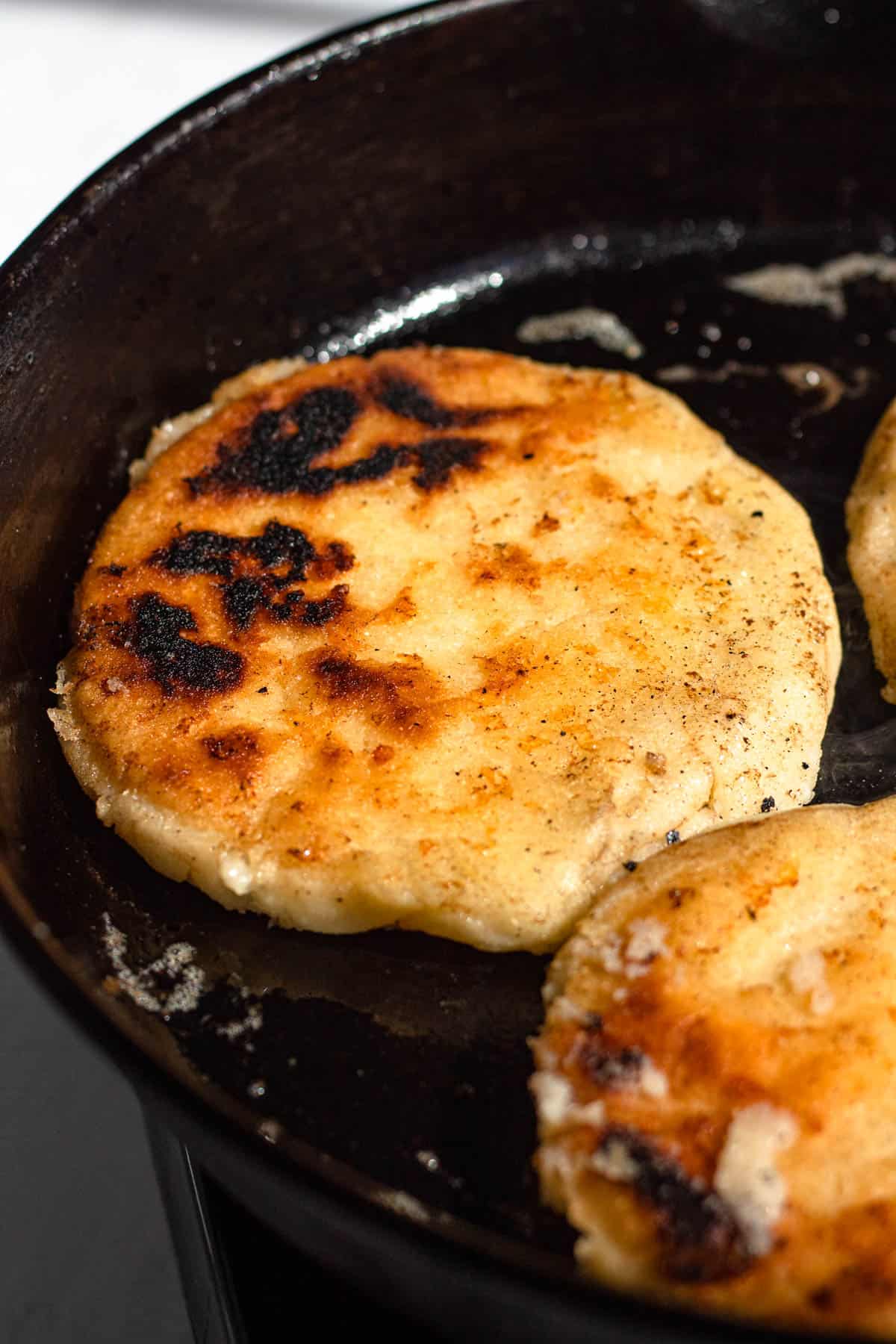
Warm a cast iron skillet or an electric griddle and then grease with 1 tbsp of butter or vegetable oil.
Place four arepas in the pan and cook over low-medium heat for 3-4 minutes until golden brown. Then flip and heat on the other side for about 3-4 minutes, or until a crust is formed on both sides. Slice with a serrated knife or top with your favorite filling and enjoy!
Recipe researched using My Colombian Recipes, Cooking with Ginnie, and Sweet and Salado
Expert Tips
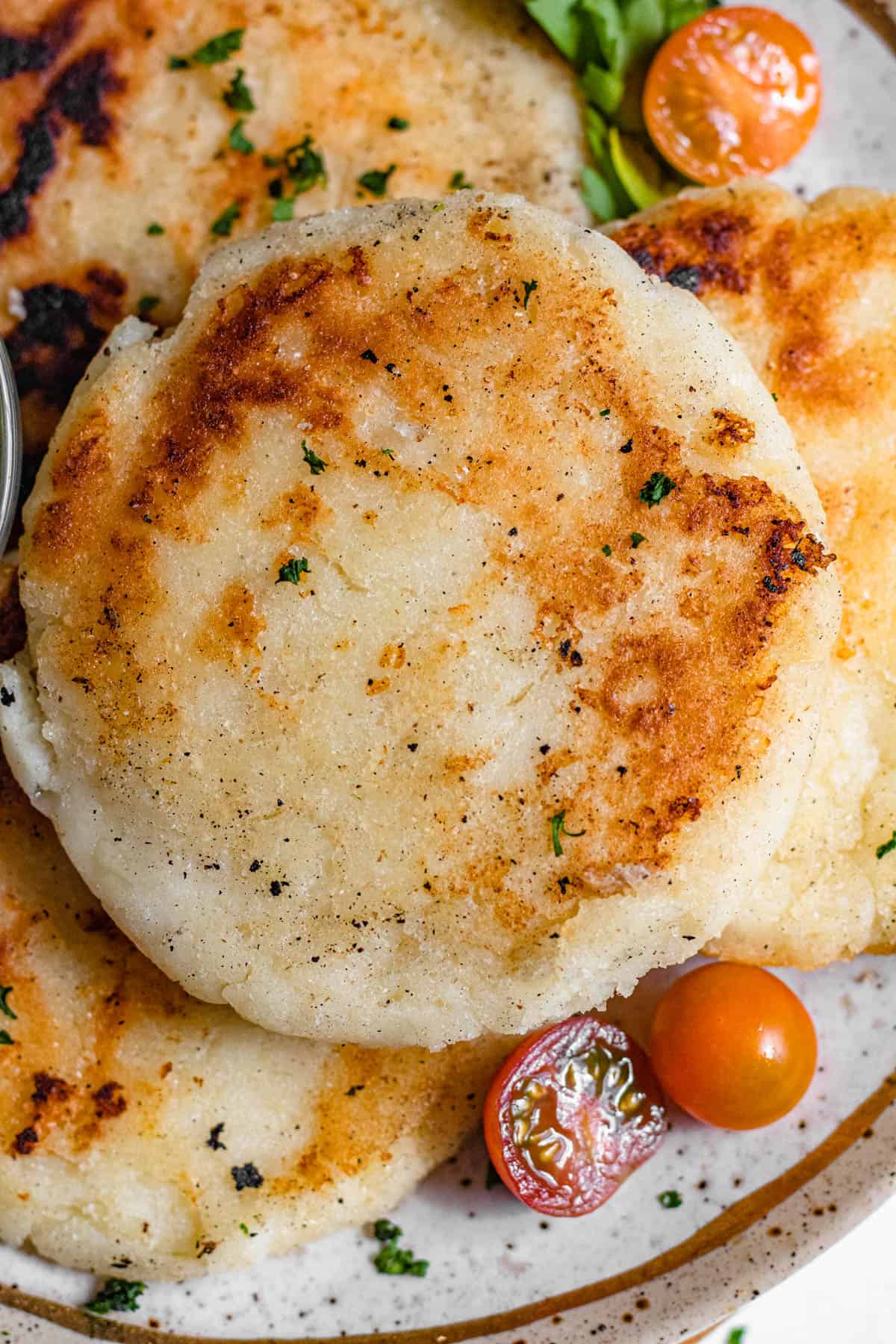
- If you find that your arepas are cracking when you try to cook them, keep a bowl of water nearby, dip your fingers in it and use that tiny bit of water to smooth out any cracks in the dough.
- Some chefs like to place the water into the bowl first and then add the flour slowly to prevent any lumps of flour. I’ve also seen chefs add the water to the flour so that they are careful not to add too much water. If you run into any issues, try doing it the other way the next time.
- Venezuelan-style arepas are often stuffed with toppings, rather than topped. You can stuff your dough balls with your favorite ingredients or favorite meat before cooking to try this way.
Filling Your Arepas
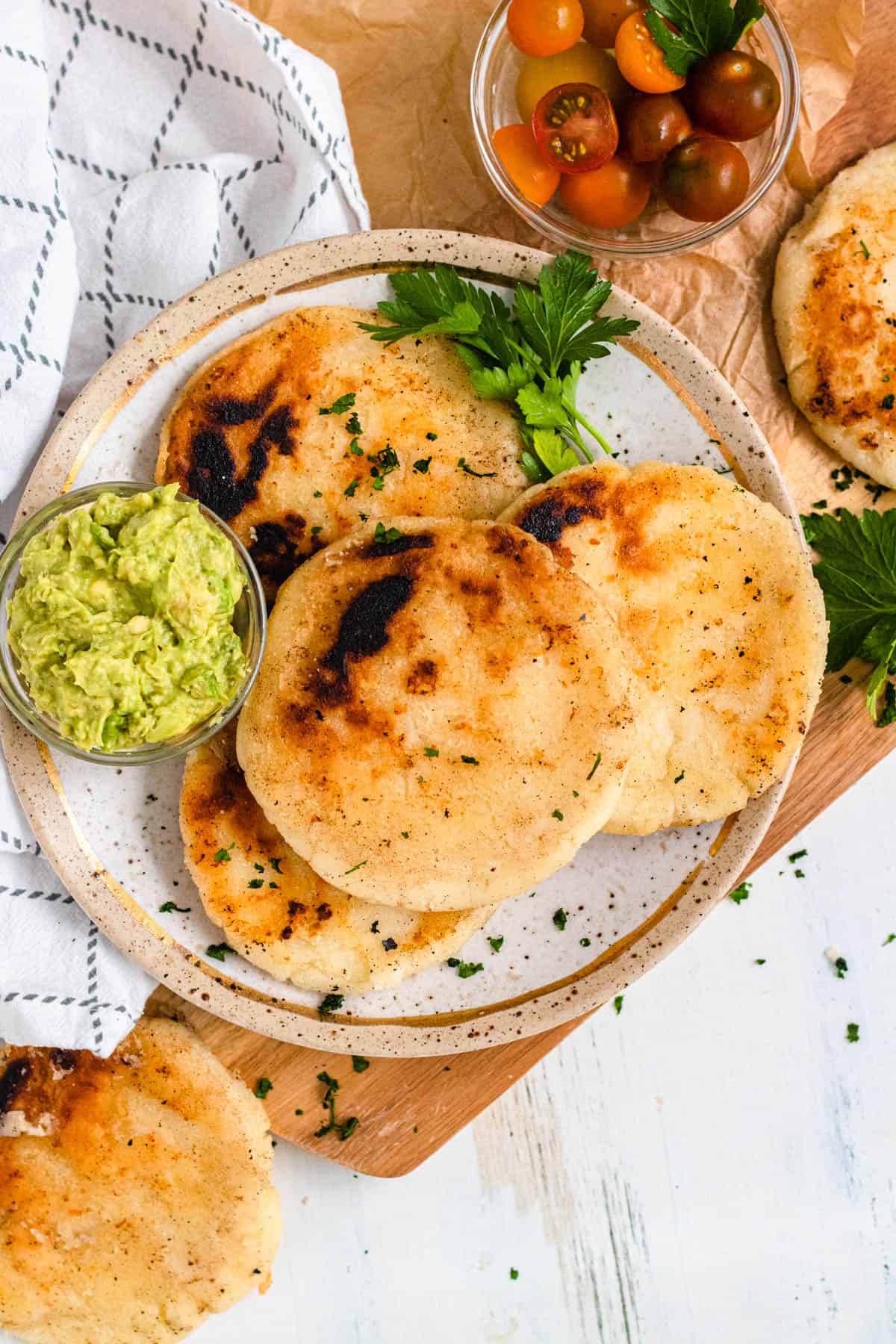
Arepas are considered a blank canvas by many chefs. There are so many toppings you can add to your arepa.
I’ve seen them served with a bit of mozzarella cheese in the United States but in Colombia they use queso fresco, cuajada or quesito.
They may also be stuffed with beef, chicken or even fish, shrimp or black beans.
Sweet arepas may be served with cheese and topped with dulce de leche or condensed milk.
At breakfast, arepas may be served as a side with eggs or topped with a bit of butter and cheese.
As a snack, arepas may be served plain.
FAQs
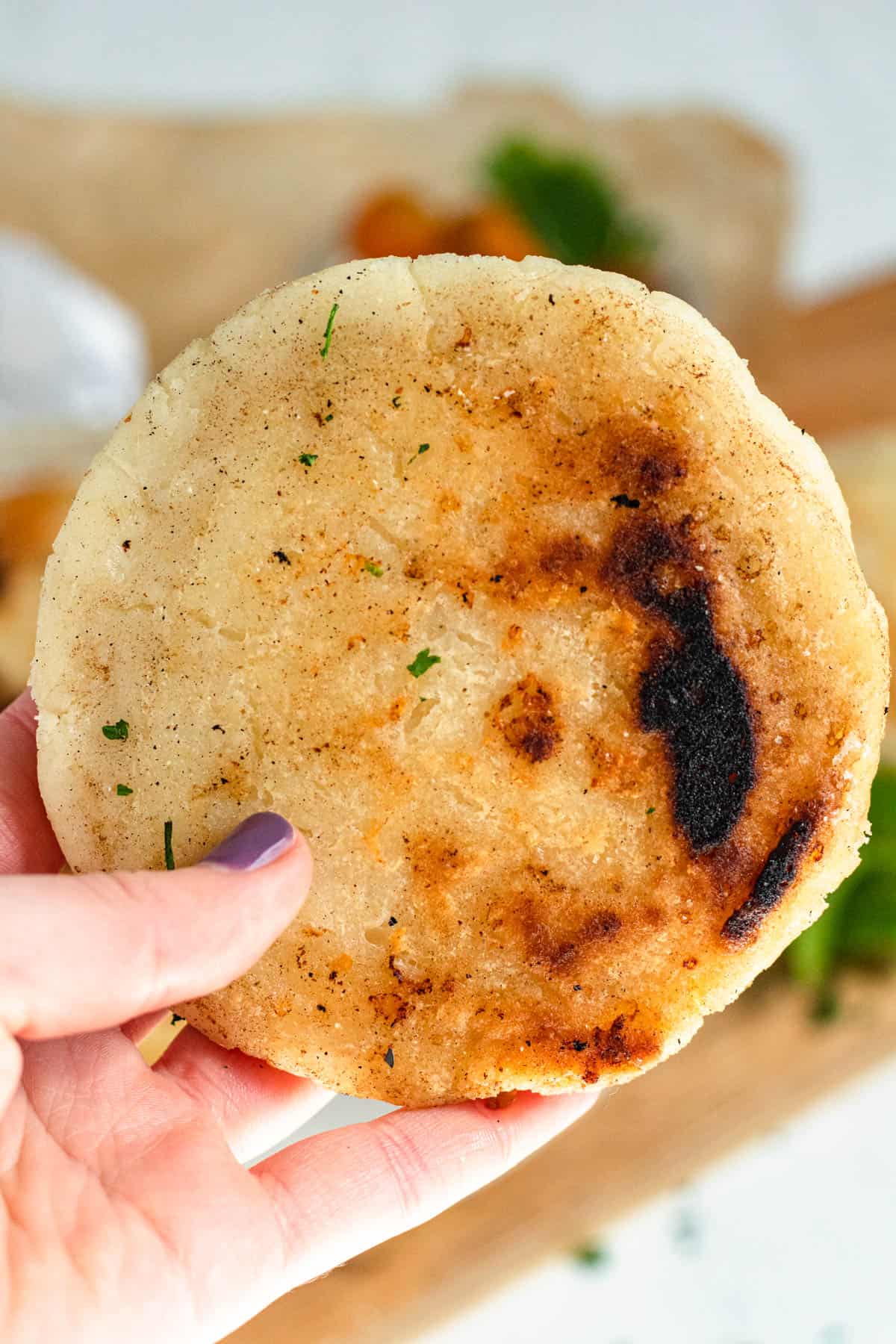
There are several differences between Pupusas and Arepas. The main difference is pupusas are larger and thicker and made with masa harina, rather than masarepa.
If you are trying to slice your arepas and finding they are a bit gooey in the middle, don’t worry. There may be two causes.
Either you made them too thick and didn’t allow them to cook long enough, or you cut in too soon. Arepas may continue to cook a bit once taken off the griddle so allowing them to rest may solve the problem.
Arepas may be a little bit mushy on the inside thanks to the cheese in the dough.
If your arepas are gooey in the middle but the outside is fully cooked, try reducing your cooking temperature. This will allow the center of the arepas to cook through before the outside is done cooking.
Yes, you can save arepas in an airtight container for a day or two, but they are undeniably the best when they are made and enjoyed fresh and hot off the griddle.
Did you like this Arepa recipe? If so, make sure to check out these other recipes I picked out just for you:
- Colombian Hot Chocolate with Cheese
- Bandeja Paisa Colombiana Recipe
- Homemade Tostones
- Pan Con Pollo from El Salvador
- Picaditas
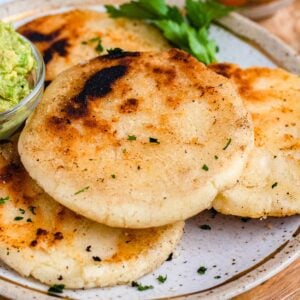
Arepa Recipe from Colombia
Equipment
- Mixing Bowl(s)
- Large Skillet or Griddle
- Box Grater
- Griddle
- Cast Iron Skillet
Ingredients
- 2 cups white cornmeal, or arepa flour
- 1 tsp Salt
- 2 cups warm water
- 1 cup shredded mozzarella cheese , 4 oz (or another white cheese. Traditional choices are queso campesino or queso costeño)
- 3 tbsp butter, softened, divided
Instructions
- In a large bowl, place 2 cups white cornmeal, 1 tsp salt, 2 cups water, 1 cup mozzarella cheese, and 2 tbsp of butter. Use your hands to mix the dough thoroughly. Cover with a towel and let it rest for 5 minutes.
- Separate the dough into 8 sections and roll each section into a ball. Press the ball flat in your hand until about ½” thick. Press the edges with your hands so that no cracks form.
- Warm a cast iron skillet or an electric griddle and then grease with 1 tbsp of butter.
- Place four arepas in the pan and cook over low-medium heat for 3-4 minutes until brown. Then flip and heat on the other side for about 3-4 minutes, or until a crust is formed on both sides.
Video
Notes
- Arepa Flour/Masarepa: Read the Arepa Flour section for more guidance on finding the right product.
- Water: Warm water will make the dough more pliable and less likely to crack
- Shredded Cheese: For an accessible option, you can use mozzarella cheese. Traditional choices are queso campesino or queso costeño.
- Butter: Softened. This is used in the dough as well as for cooking on the griddle.
- If you find that your arepas are cracking when you try to cook them, keep a bowl of water nearby, dip your fingers in it, and use that tiny bit of water to smooth out any cracks in the dough.
- Some chefs like to place the water into the bowl first and then add the flour slowly to prevent any lumps of flour. I’ve also seen chefs add water to the flour so that they are careful not to add too much water. If you run into any issues, try doing it the other way the next time.
- Venezuelan-style arepas are often stuffed with toppings, rather than topped. You can stuff your dough balls with your favorite ingredients or favorite meat before cooking to try this way.





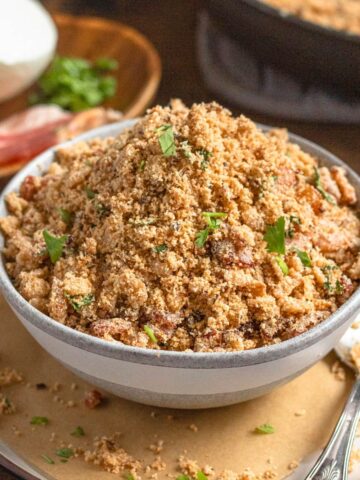


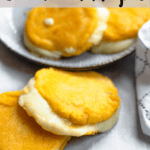
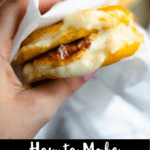


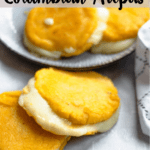








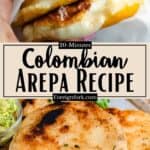
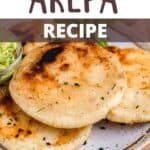

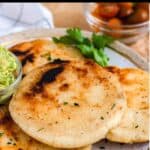
Donna says
So many Karen’s on here! Just make it and eat it however you want! My husband says, “it all turns to the same thing anyway!”
Alma says
There is a Colombian restaurant here that makes them and chicken and they have a sweet taste something like marscopone maybe. Is this used ?
The Foreign Fork says
Hi Alma, I am not sure as I have never heard of that! But I am publishing your comment so that hopefully other readers can chime in 🙂
Kay Pea says
Another Colombian commenter here. I grew up in the US but my mother made arepas very often when I was growing up. Originally, she would cook and grind the corn herself, but later on switched to the precooked corn meal.
One thing I’d like to note is that the cheese that is traditionally used is NOT mozzarella cheese, but “quesito” (queso fresco) or queso campesino.
I cannot speak for Venezuelans, but in the part of Colombia where my family is from they make sweet and savory arepas. Savory arepas are made with a dough made of white corn. We often eat them for breakfast with butter and cheese, but also as a starchy side for lunch/dinner (like a grilled steak with a side of arepa). Sweet arepas are arepas de choclo, which are made with a thick batter of sweet yellow corn. The batter has sugar added for sweetness, plus egg and sometimes milk. It’s typically served plain or with cheese in the middle. You recipe kind of looks like it took elements from both preparations.
Maria says
I made these with a tiny modification and they were delicious! My girlfriend is from Colombia and she does what Gloria does as adds a bit of creamed corn to the masarepa to mimic the hand ground corn her mother used to do. I used your recipe and added the creamed corn and split them and added the cheese. Delicious!! (She used to add an egg to hers sometimes for a breakfast arepa too). Definitely keeping your recipe.
The Foreign Fork says
I’m so glad that your girlfriend approved Maria! Thank you for the comment 🙂
Carlos says
Don’t let the negative comments put you down. This is an arepa I would love to try!
I am from Medellín, one of the cities in Colombia where we eat arepas for breakfast, lunch, dinner, snacks, and any other time of the day, and I’ve eaten arepas made of ground corn, cornmeal , ground chocolo, yuca, nuts and seeds, etc. We usually make them grilled or fried, but I’ve seen other ways of cooking them, like microwaved, in an oven as some sort of pizza, etc.
Arepas are like tortillas, in the sense that they are very neutral in flavor and, because of that, are commonly used as a means to bring together many other ingredients and flavors. So, it’s usual to top them or stuff them with different kinds of cheese, meats, vegetables, poultry, sweets (e.g. dulce de leche), etc.
Arepas can also be eaten plain, with just butter and salt, which is very common here in Colombia. Many people also add queso fresco, cuajada (a very low-salt version of queso) or quesito (a more salty and granulated variation of queso) on top, to this more plain and traditional variation.
One variation that surprises every person who tries it (even the judges on our local Master Chef TV show, which every season has an arepa challenge) is a grilled arepa, stuffed with mozzarella cheese and topped with condensed milk. This variation is very popular here in Medellin, but not so much in the rest of the country. Personally, I don’t love it, but many close friends and relatives swear by it. My favorite variation would be arepa-e-huevo, a double deep-fried, egg-stuffed arepa, very popular in our coastal cities, but then again, many people just don’t like them. This just goes to show you that there’s no right or wrong way.
I’ve been all over Colombia as well, and have eaten many arepa recipes. The combinations and possibilities are endless. Many people will try to tell you that their way is the only “right” way to eat an arepa, but that’s just a “purist” way of seeing things. So keep trying to make your own, don’t be afraid to experiment, and please keep promoting our Colombian food. Many of us love reading articles like this, from people from other countries, promoting our food, culture, people, etc. So, please, keep up the good job.
Phil says
This is not a colombia arepa at all. You are so far off base on the preparation and final product. I am Colombian and make arepas weekly. Please consult a real Colombian instead of stealing an idea you saw at a good festival in NY.
S. Renee Tucker says
Since you made the effort to post a comment and know how to make these correctly, why don’t you share that information?
Migdalia says
Phil,
Too rough. She clearly said that she accepts advice on how that recipe is prepared in Colombia. If you are so Colombian, you are leaving your country very low with your rudeness. If you know how to make your Arepas, why didn’t you publish your delicious recipe? Maybe you are just feel jealous. 😱🤭🤔
Matt says
She literally says up top that she tries doing the best research she could to make sure her recipes are close to authentic. Instead of being critical and condescending, maybe try and help?
Jessica Bonds says
I’ve read like 100 recipes for arepas today and they vary greatly from region and family tradition.
Gloria Montoya Romero says
Hola! Hola!! First of all .. thank you for trying our Colombian food. And even more, for loving it so much that you dare to try making it YOUR WAY! There’s no wrong in any way in your recipe at all… Colombians make arepas with their own style depending on their region… But those are the basic ingredients to make arepas commercially. I congratulate you -even if you put together two: I applaud you! Kiddos to you!!! But if you want, to make them from scratch… Build some muscle grinding the corn… The taste is insane!
I’m from Barranquilla, the cost of Colombia. We also make arepas fritas with an egg inside. I’m lazy with the grinding of the corn, so I buy a can of sweet corn and mix it with the masarepa and fry them in deep oil. For that you have to have a “caldero.” When the arepa is ready, she will float up, turn it over and there you have a chuby arepa frita to fill with anything. In regards to the cheese, we don’t use mozzarella… It’s more a chewy, salty cheese called “quedó Costeño” Also… Arepas are good right out of the caldero to your plate… Cold arepas are not fun! Finally Don’t let anyone bother you with bully comments. You did what i would do if I went to a different country and loved the cuisine so much, that I dare to TRY making it to enjoy it any time I want. Thanks for sharing our Colombian culture, when those who could’ve, didn’t! Love what you do and keep it up!!! Gloria
Dianna says
Hi there, I’m an indigenous woman from the Caribbean and parts of Columbia. I’m not sure where you heard the term “erepas” meaning corn but it’s actually “maisi” in many Arawakan tribes (some of them located in Columbia/Venezuela, as well as the Caribbean, which is also where arepas originated, between these tribal groups). Also, it’d be more respectful to us native folks if you actually named the tribes of where these words derive etc. We’re usually lumped together as a monolith, like the “indigenous word” or “the indigenous people” when really we all have our individual nations, customs, regalia, ceremonies and so on and as I’m sure you can understand, that tends to be exhausting. Thanks!
The Foreign Fork says
Hi Dianna,
Thank you very much for the note on the correct way to refer to these groups! I hadn’t thought about that before, but your explanation makes a lot of sense to me and I will work that into future posts 🙂 Have a great day!
A. says
Dianna,
You are from Colombia? Řeally? Colombia with an o not Columbia with a u.. I never knew a Colombian that wasn’t bugged by that misspelling. Haha
Jessica says
Colombian here. I grew up with these being made all the time. The way you are making with the cheese in the middle between two arepas is something I have never seen.I have family from various parts of Colombia all of which have their own regional take on it. But not this. To me, your spin makes it seem more like a quesadilla. Pleas don’t do that. The cheese is to be incorporated into the dough. Or you could make your ball of dough and then add grated cheese and close it up, roll into a ball and flatten. DO NOT use two arepas as if they were tortillas and add cheese. That’s not an arepa.
The Foreign Fork says
Hi Jessica,
Thank you for taking the time to write this comment! Just for clarification, in this recipe the arepa is cut in half and stuffed with cheese, so it’s still in the middle… not necessarily 2 arepas.
Regardless, I understand what you are saying and appreciate the insight! The reason I developed this recipe like this was because I went to a Colombian food festival in New York and this was how the arepas were served. I understand now though that it may be different in Colombia! I will keep your note in mind when updating this recipe. Thank you again!
Nick says
My husband is from Colombia. To him, they are a breakfast food. (Though, of course, like all breakfast foods, can be eaten at any time of day!) He doesn’t cut them or put anything inside them. When they are done he spreads butter over them, sprinkles salt, and then lays slabs of queso blanco on top. Because of the type of cheese, it isn’t meant to melt.
They. Are. Delicious.
Virginia Soares says
I’m always looking for something new. So tired of same ‘ol. Any idea about nutritional value and calorie/carb count?
Not 19 anymore.
V Soares
The Foreign Fork says
Hey Virginia! I agree, trying something new makes mealtime so much more interesting! I actually don’t include nutritional information in my recipes, but if you put the ingredients into My Fitness Pal or something similar, it will calculate it for you! Hope that helps 🙂
Danielle says
Hi I’m from Cali Colombia and I find it interesting how you made these. These look yummy but doesn’t really look like the ones my family make on the weekend. I suggest trying to use white corn meal and hot water. The hot water makes the mix a lot softer. Cook them with less than a tablespoon of butter to have some color for each side. Can you try them out this way please??
Desiree says
Is it okay to prep them and then put them away until you’re ready to start making them again?
The Foreign Fork says
Yes that should work totally fine! 🙂
Doris says
When using an electric griddle, is there a particular temperature to cook at? Mine are coming out dense and undercooked in the centre, so im thinking I need a higher temperature
The Foreign Fork says
Hi Doris! The arepas do tend to be dense. However, it shouldn’t be undercooked in the middle. If your arepas are crispy on the outside but undercooked on the inside, you are likely cooking them at too high of a temperature. I would recommend lowering the temperature a bit. That should help 🙂
Brett E Singleton says
So easy and so good! Fried in lard for extra flavor! Made 6 instead of 8 from the 2 cups. Slightly thicker and cooked at slightly lower temp and longer – flipping several times gave me the perfect results. Ate 3 – 1 with cheese & fried egg, 1 with cheese and 1 with fresh tuna salad w/pineapple. OMG – will make these over and over and over!
The Foreign Fork says
Hurray Brett, I am so glad that you liked them!!! The fried egg one sounds AMAZING
Neha says
I love the sound of these! Video is super helpful, I have a lot of corn meal to be put to good use, found this recipe in time. 😉
The Foreign Fork says
Hurray, I’m glad you found the video helpful! I can’t wait to hear how they turn out 🙂
Angela says
I haven’t had an arepa but these look amazing. Can’t wait to try them!
The Foreign Fork says
Now is a great time!!! You’re going to love them 🙂
safira says
I have never made Arepas and can’t wait to make them. Love that there are only 4 ingredients!
Jessica Formicola says
We’ve made these several times over the past couple months and they turn out perfectly every time! Thanks so much for sharing the recipe!
The Foreign Fork says
Hurray, I’m so glad that you love them! They are a favorite in our house too.
Jill says
I’ve not tried arepas before but now I definitely want to. Your photos are making me drool.
The Foreign Fork says
Thank you so much Jill! Definitely try them out 🙂
Carol Torro says
They look great.
Alexandria Drzazgowski says
Thank you Carol!!